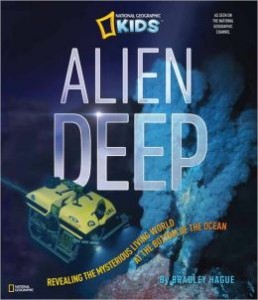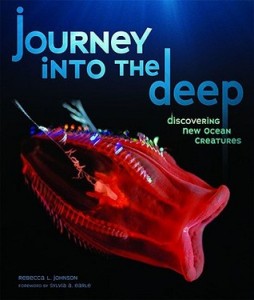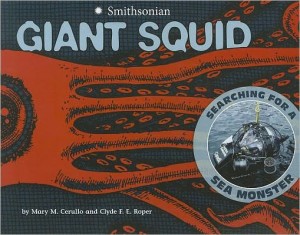What Lies Beneath: Weird and Unusual Marine Life | Nonfiction BookTalker
Animals with transparent guts! Fish that make their own light! An underwater bird? It’s not a horror movie or science fiction. It’s happening right now roughly 36,000 feet below sea level. Booktalk audiences hungry for adventure and monsters can find both in remarkable books on marine mysteries. While the following titles are aimed at fourth grade and above, even younger readers will find the pictures irresistible.
 The International 2000–2010 Census of Marine Life set out to explore the ocean’s depths and the diversity of its life forms. What the group of marine scientists found will take your breath away. Bradley Hague’s Alien Deep: Revealing the Mysterious Living World at the Bottom of the Ocean (National Geographic, 2012) describes the discovery of hydrothermal vents. Show your booktalk audience the awe-inspiring photos (pp. 14–15) of super-hot jets of water surrounded by utter darkness and creatures that thrive in such an environment. On pages 38 and 39, smiling oceanographers are pictured holding an eight-foot-long, vent-loving tubeworm. The vents disappear under the Earth’s accumulating crust as new ones form. The constantly changing environment excites and challenges the experts who once believed that nothing could live without photosynthesis.
The International 2000–2010 Census of Marine Life set out to explore the ocean’s depths and the diversity of its life forms. What the group of marine scientists found will take your breath away. Bradley Hague’s Alien Deep: Revealing the Mysterious Living World at the Bottom of the Ocean (National Geographic, 2012) describes the discovery of hydrothermal vents. Show your booktalk audience the awe-inspiring photos (pp. 14–15) of super-hot jets of water surrounded by utter darkness and creatures that thrive in such an environment. On pages 38 and 39, smiling oceanographers are pictured holding an eight-foot-long, vent-loving tubeworm. The vents disappear under the Earth’s accumulating crust as new ones form. The constantly changing environment excites and challenges the experts who once believed that nothing could live without photosynthesis.
 Ask your booktalk listeners if they’ve ever seen a jumbo jet. Then tell them that if divers were to explore the deepest parts of the ocean, it would feel as though 50 jumbo jets were piled on top of them. Special unmanned vehicles dive down, photographing and recording what we would otherwise never see. According to Rebecca L. Johnson’s Journey into the Deep (Millbrook, 2011), the marine census discovered thousands of previously unknown species. Take a peek at the rainbow-colored lobster (p. 11). Observe how the barreleye fish (p. 18) rolls its eyes in different directions—including backwards—allowing it to look straight through the top of its transparent head. The translucent siphonophore, which resembles an interstellar spaceship, is more than six feet long (p. 30). And you can easily guess how the spiral poo (p. 37) got its name.
Ask your booktalk listeners if they’ve ever seen a jumbo jet. Then tell them that if divers were to explore the deepest parts of the ocean, it would feel as though 50 jumbo jets were piled on top of them. Special unmanned vehicles dive down, photographing and recording what we would otherwise never see. According to Rebecca L. Johnson’s Journey into the Deep (Millbrook, 2011), the marine census discovered thousands of previously unknown species. Take a peek at the rainbow-colored lobster (p. 11). Observe how the barreleye fish (p. 18) rolls its eyes in different directions—including backwards—allowing it to look straight through the top of its transparent head. The translucent siphonophore, which resembles an interstellar spaceship, is more than six feet long (p. 30). And you can easily guess how the spiral poo (p. 37) got its name.
 Erich Hoyt’s Weird Sea Creatures (Firefly, 2013) explains that the deep ocean is more typical of our planet than any other place on Earth. Oceans comprise more than 90 percent of the world’s living space, yet only 1 percent of them have been explored. It’s certainly time to start studying the astounding life there. Most of the animals residing in the ocean depths either make their own light or rely on echolocation (like bats) to navigate the darkness. Scientists don’t understand the process fully and much remains to be learned.
Erich Hoyt’s Weird Sea Creatures (Firefly, 2013) explains that the deep ocean is more typical of our planet than any other place on Earth. Oceans comprise more than 90 percent of the world’s living space, yet only 1 percent of them have been explored. It’s certainly time to start studying the astounding life there. Most of the animals residing in the ocean depths either make their own light or rely on echolocation (like bats) to navigate the darkness. Scientists don’t understand the process fully and much remains to be learned.
The photos in Hoyt’s book are stunning. One of my favorite booktalk creatures of all time, the deep-sea anglerfish, is rivetingly displayed (p. 9). And don’t miss the zombielike Sloane’s viperfish (p. 35) which holds the world’s record for the largest teeth in relation to its head.
 Mary Cerullo’s Giant Squid: Searching for a Sea Monster (Capstone, 2012), cowritten with renowned squid researcher Clyde F.E. Roper, covers one of the best booktalk topics ever. The giant squid lives so deep in the ocean that for centuries, most people didn’t believe it existed. Sailors, who treasured the valuable lumps of ambergris found in dead sperm whales, had been mystified by what looked like beaks of giant birds stuck in the center of many of them. What kind of bird could live at the bottom of the ocean?
Mary Cerullo’s Giant Squid: Searching for a Sea Monster (Capstone, 2012), cowritten with renowned squid researcher Clyde F.E. Roper, covers one of the best booktalk topics ever. The giant squid lives so deep in the ocean that for centuries, most people didn’t believe it existed. Sailors, who treasured the valuable lumps of ambergris found in dead sperm whales, had been mystified by what looked like beaks of giant birds stuck in the center of many of them. What kind of bird could live at the bottom of the ocean?
No bird. The beaks came from the whales’ favorite meal—squid, particularly giant squid with giant beaks. The ambergris formed around squid’s sharp mouth parts like pearls around grits of sand. Some beaks were the size of a grapefruit. (Be sure to display the photos of Roper lying next to a dead giant squid to show the creature’s size.) Scientists estimate that one sperm whale may consume as many as 20,000 squid per week, though only three are giant squid. Based on that number, as many as 60 million giant squid are eaten by whales every year.
The pictures in these books show just part of the wondrous deep-sea world. Offer these titles to your listeners for the adventure of a lifetime.
RELATED
The job outlook in 2030: Librarians will be in demand
The job outlook in 2030: Librarians will be in demand
ALREADY A SUBSCRIBER? LOG IN
We are currently offering this content for free. Sign up now to activate your personal profile, where you can save articles for future viewing






Add Comment :-
Be the first reader to comment.
Comment Policy:
Comment should not be empty !!!